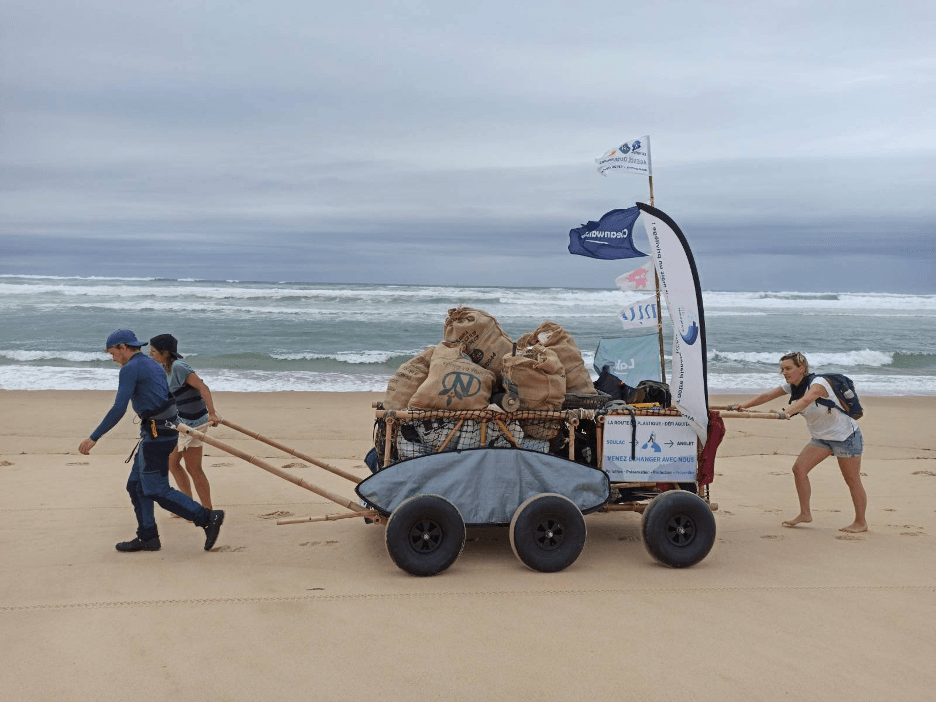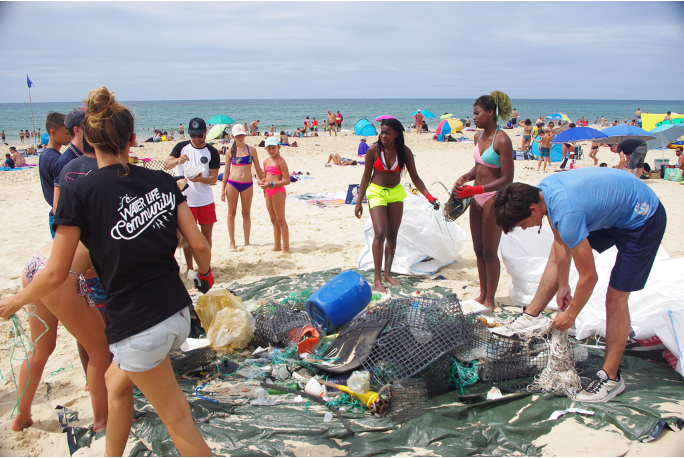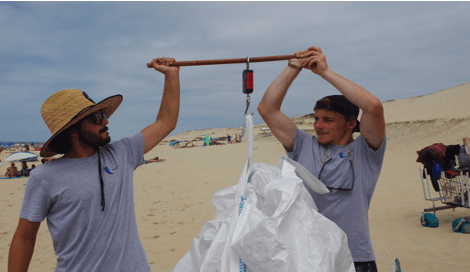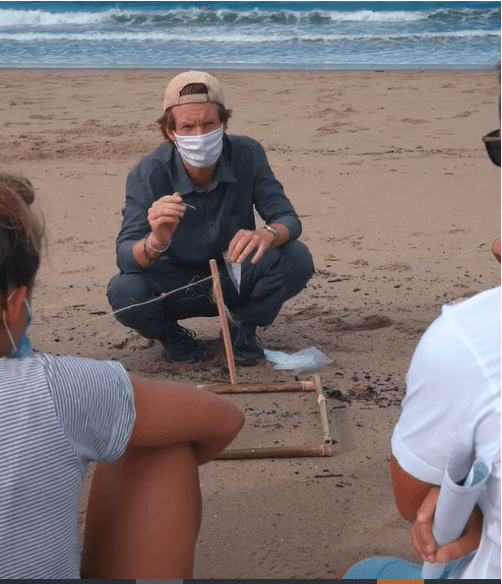The Plastic Road™ (La Route du Plastique)

Figure 1: Aurélien Strmsek the co-founder of 4P SCIENSEAS and two volunteers pulling and pushing the “4P Thompson”, 4P's second eco-designed and low-tech trolley.
THE PLASTICS PROBLEM
Plastic, derived from the polymerization of molecules extracted from oil or natural gas, was invented as the first synthetic polymer in 1907. By the mid-20th century, the material began to revolutionize the way we live and work, particularly in industry and shipping. Plastic became a common material because of its lightness, resistance, low cost, and the fact that it is easy to manufacture and mold.
In 1950, 1.5 million tons were produced. Each year since then, production has increased by approximately 8.5%, reaching 368 million tons in 2019. More than two-thirds of plastic waste is burned or buried; however, scientists estimate that between 4.8 and 12.7 million tons of plastic still reach the ocean every year.1 Some 5400 million tons—60% of all plastics ever produced—were discarded and are accumulating in landfills or in the natural environment.2 These plastics move through watersheds to the oceans, while the rest comes from sea-based sources such as fishing and aquaculture.
The effects of plastics on the environment are numerous. Media are littered with photos and stories of animals trapped, entangled or having consumed plastic—typically macroplastics (pieces larger than 5 millimeters [mm]). However, we are just beginning to understand the effects of smaller plastics on the ecosystem—known as microplastics (pieces of 5 mm or less in length). Microplastics come from the degradation of macroplastics already in the aquatic environment (secondary microplastic) or enter the aquatic environment directly in their microscopic size (primary microplastic), the latter sources being disintegration of vehicle tires, paints, or clothing, or virgin pellets that are used in plastic manufacturing.

Figure 2: Volunteers helping to sort the waste from a citizen emergency clean-up during the first "Plastic Road™".
THE PROJECT
EcoWB is partnering with 4P SCIENSEAS, a French non-governmental scientific organization established to participate in the conservation and clean-up of coastlines by conducting citizen science research projects. 4P SHORE & SEAS created the concept of the “Plastic Road™” to link scientific research with awareness-raising and beach cleanups in order to share the richness, importance and beauty of the ocean. For the past three summers, volunteers have conducted this effort along the Atlantic coastline of France.
During a Plastic Road™ event, volunteers walk along a sandy coastline in pairs, alone, or in small groups, pulling a handmade, sustainable trolley for a minimum of two weeks. During these walks, the volunteers not only collect debris, but conduct scientific sampling for both macro- and microplastics, observe oceanic and atmospheric parameters, and conduct public awareness events, such as “scientific café” events where PhD students and researchers speak about ocean conservation and the environment.
In addition to its scientific commitment, clean-up actions and its mission to raise awareness, this project also enables the participants to:
- Create many social contacts and share a unique experience with friends or family,
- Explore new psychological and physical experiences,
- Realize the scale of the plastic pollution problem,
- Have access to a multi-disciplinary team (four to five days with researchers, coastal lifeguards, environmental and coastal managers, a communications manager, and a trainer in sustainable development communication and ecological transition), and
- Enjoy the freedom and richness of the coastline and ocean.
After the walks, data are analyzed and scientific publications written regarding distribution and origin of the debris. Data are also compared from year to year and between different sandy coastlines. Results are also shared with the general public. The data can inform public policy and regulations to reduce plastic contamination and over-consumption.

Figure 3: Aurélien Strmsek and Nicolas Couetard the 4P's scientific director weighing a big bag of waste collected on a French beach

Figure 4: Edgar Dusacre the co-founder of 4P SCIENSEAS explaining the microplastic protocol to a class of master students.
SCIENTIFIC PROTOCOLS
There are currently no established international guidelines for collection or analysis of marine debris, though efforts are underway to develop consistent approaches that will allow for comparability and improved data sharing. 4P SCIENSEAS has developed field sampling and analysis protocols specific to macroplastics and microplastics. The macroplastics protocol was inspired by the OSPAR Commission,3 while the microplastics protocol was created within the French research project called “ARPLASTIC” undertaken by the EPOC (Continental and Oceanic Environment and Paleoenvironment) and CBMN (Institute of Chemistry and Biology of Membranes and Nano-objects) laboratories of the University of Bordeaux, France. The microplastic protocol was inspired by the protocol developed by CEDRE (Center for documentation, research and experimentation on accidental water pollution, a French State-approved association with a public service mission) that aims to monitor microplastics within the sediment through a standardized protocol in the framework of the OSPAR (OSLO-PARIS) convention and the Marine Strategy Framework Directive (MSFD) of the European Union.
In an effort to ensure that the data collected will be available to the global community, we are engaging in discussions with organizations that already have databases. This includes the National Oceanic and Atmospheric Administration (NOAA) in the U.S., and the Global Partnership on Marine Litter (GPML). We aim to determine whether Plastic Road data can be incorporated into these existing databases, such as the GPML Data Hub, which maintains a project database sourced from the NOAA Marine Debris Monitoring and Assessment Project (MDMAP), Ocean Conservancy’s International Coastal Cleanup and the European Environmental Agency’s Marine Litter Watch (MLW).
Activities and Plans
EcoWB and 4P SCIENSEAS are joining forces in an effort to export The Plastic Road™ to another country as a pilot, and hopefully expand it to multiple sites around the world. Through replication of this project at various and multiple beaches/coastlines globally, we expect to contribute to scientific research on this critical topic, engage new partners, and reach new public audiences through participation and outreach.
The team is currently searching for an appropriate pilot site for expansion of The Plastic Road™ outside of France that meets project requirements. This involves finding an appropriate sandy coastline meeting specific conditions, along with identifying local university and NGO partners. Once the site is chosen, 4P SCIENSEAS will provide the project expertise, including training and trolley specifications. They will also meet with project partners onsite to demonstrate the approach and protocols. The Plastic Road™ will continue to generate data and community interest into the future by repeating the research on an annual basis at each site.
Contact
For more information, or if you would like to propose a beach for this collaborative project, please contact Autumn Iverson at autumn.iverson@ecowb.org
References
- Jambeck J, Geyer R, Wilcox C, et al. Plastic waste inputs from land into the ocean. Science (80- ). 2015;347(6223):768-770. doi:10.1126/science.1260352
- Geyer R, Jambeck JR, Law KL. Production, use, and fate of all plastics ever made. Sci Adv. 2017;3(7):3-8. doi:10.1126/sciadv.1700782
- OSPAR. Guideline for monitoring marine litter on the beaches in the OSPAR Maritime Area. OSPAR Comm. 2010;1:84.
